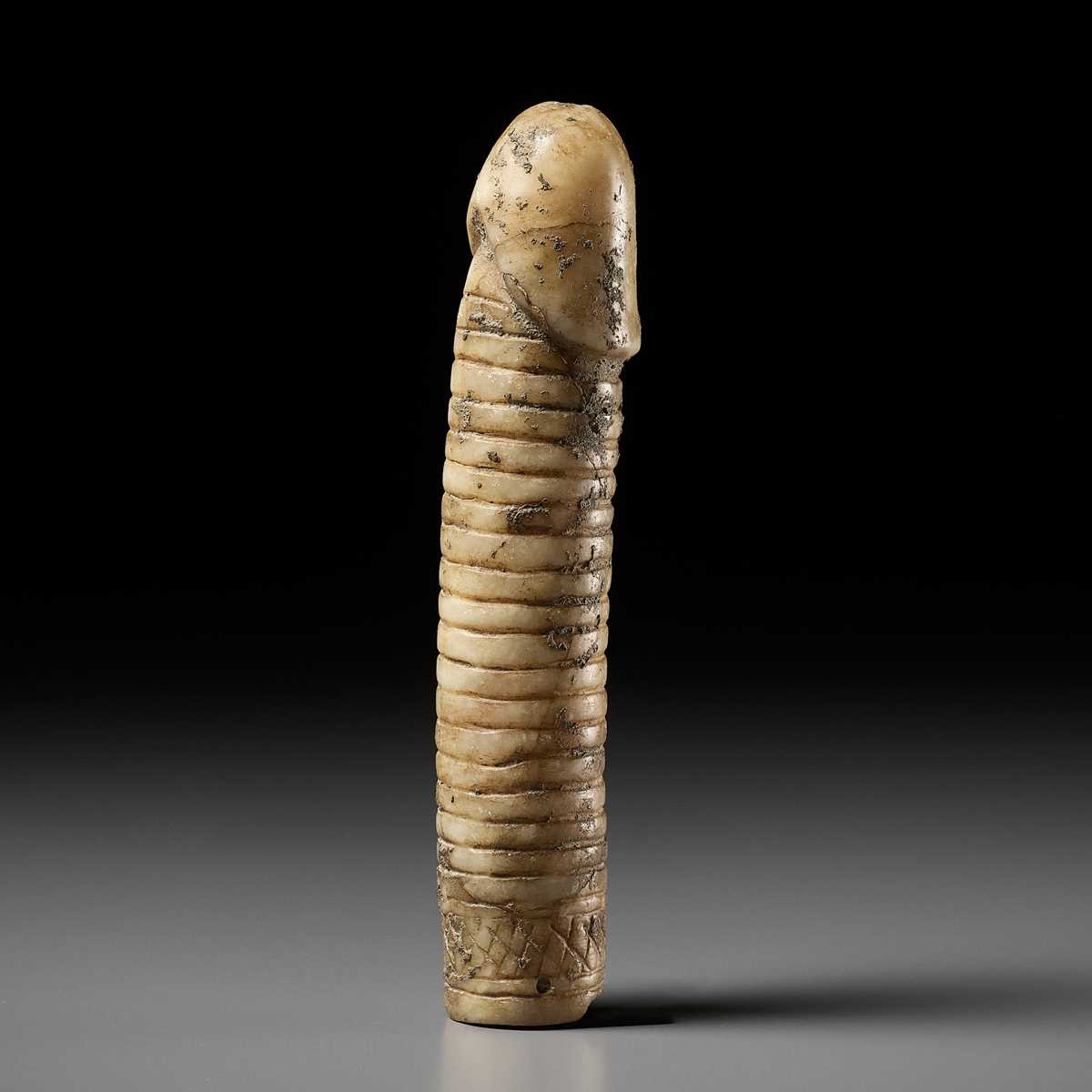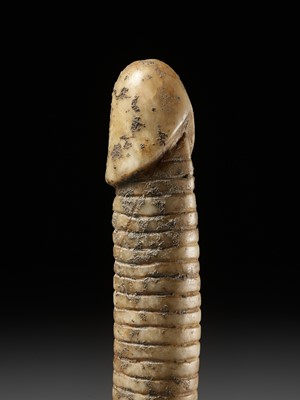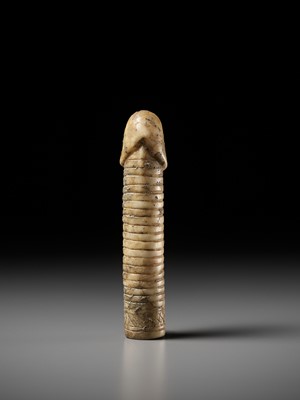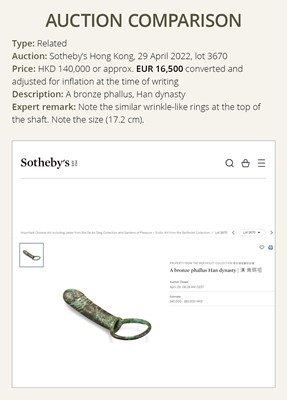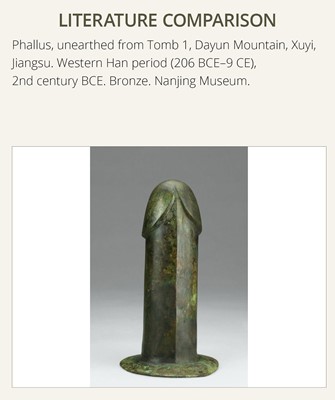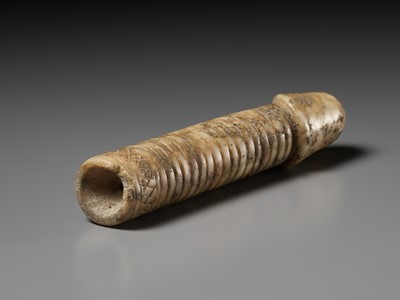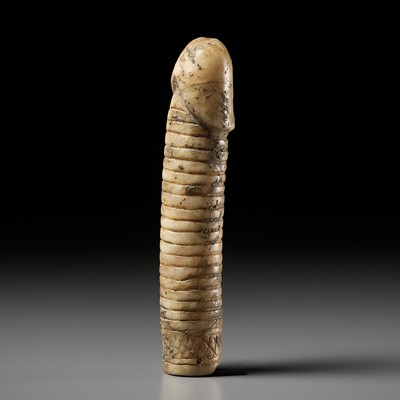1st Mar, 2024 10:00
The No Reserve Dragon Sale
76
A RARE WHITE MARBLE CARVING OF A PHALLUS, WESTERN HAN DYNASTY
西漢漢白玉玉勢
Sold for €1,560
including Buyer's Premium
Please note this Lot is to be sold at No Reserve. 本拍品不設底價
China, 206 BC-8 AD. The realistically carved elongated phallus is decorated with rings along the shaft and with a cross-hatched decorative band at the base. The base has a domed recess inside that is pierced horizontally for suspension. This recess has a second aperture that extends to the tip of the phallus.
Provenance: Bonhams, Hong Kong, December 16th, 2022, lot 351. Note that Bonham’s experts originally dated this lot to the Tang dynasty.
Condition: Good condition commensurate with age. Signs of wear, weathering, and erosion. Minor nicks and losses. Soil encrustations overall, issuing from an extended period of burial. These encrustations cannot be easily removed, and they have left distinct marks to the mineral. The stone with natural inclusions and fissures, some of which have developed into hairline cracks. Fine, naturally grown golden-brown patina overall.
Weight: 431.7 g
Dimensions: Length 18.9 cm
Please click here to read the full description
Expert’s note: Similar to the few known phallus sculptures from ancient China, the heavy encrustation from extensive burial is evidence of its (eventual) use as a grave good. The elaborate carving with great attention to detail and the two apertures, one for suspension and one for added realism, suggest the elite status of the person with which this was buried.
Phallic objects carved from stone, or cast from metal or terracotta, are common subjects of any major ancient culture. Throughout time, the phallus was seen as an emblem of life and procreation. Not only did it have the power to induce fertility, but it also had an equally important role as an auspicious emblem which would ward off diseases. The practice of castration and the employment of court eunuchs, likely established in China during the Sui dynasty, added a secondary role of model phalli: the restoration of manhood after death (court eunuchs would be buried with their detached genitalia). However, this multifaceted subject remains somewhat of a taboo, which has contributed to relatively scarce publications about ancient Chinese erotic sculpture.
Phalluses of various materials, believed to be associated with fertility rites, have been made in various prehistoric cultures in the Yellow River basin. Later in the Shang dynasty, when pictographic language emerged, the character zu (ancestor) closely resembled the male sexual organ, indicating the significance of the male role in ancient Chinese ancestry.
Literature comparison:
Compare two similar bronze phallus excavated from a tomb in the Dayun Mountain, Xuyi, Jiangsu, dated to the Western Han dynasty, in the Nanjin Museum, included in the exhibition Tomb Treasures: New Discoveries from China’s Han Dynasty, Asian Art Museum, San Francisco, 17 February-28 May 2017. Compare two bronze V-shaped double-phalli, excavated in the tomb of Prince Zhongshan (Liu Sheng), dated to the Han dynasty, published in Mancheng Han mu Fajue Baogao (Excavation Report of the Han Dynasty tomb at Mancheng), Beijing, 1980, vol. 1, pp. 100. The former was unearthed together with a pair of matching stone pebbles, illustrated ibid., vol. 2, pl. LXI, fig. 2.
Auction result comparison:
Type: Related
Auction: Sotheby’s Hong Kong, 29 April 2022, lot 3670
Estimate: HKD 140,000 or approx. EUR 16,500 converted and adjusted for inflation at the time of writing
Description: A bronze phallus, Han dynasty
Expert remark: Note the similar wrinkle-like rings at the top of the shaft. Note the size (17.2 cm).
点此阅读中文翻译 (Chinese Translation)
西漢漢白玉玉勢
中國,公元前206年至公元八年。雕刻逼真的細長陽具,底部飾有交叉紋飾帶。底座內部有一個圓頂凹槽,水平穿孔用於懸掛。凹出有延伸至陰莖尖端的第二個孔。
來源:香港邦翰思,2022年12月16日。請注意邦翰思專家認爲這件拍品來自唐代。
品相:狀況良好,有磨損、風化和侵蝕的跡象,輕微劃痕和缺損。總體而言,土壤結殼是由於長期在地下而產生的。這些結殼不容易去除,並且在大理石上留下了明顯的痕跡。石料具有天然内沁和裂隙,有的已發展成裂紋。整體呈精美的金棕色包漿。
重量:431.7 克
尺寸:長18.9 厘米
文獻比較:
比較兩件戰國時期青銅勢,出土於江蘇大雲山江都王陵,收藏於南京博物館,展覽於《Tomb Treasures: New Discoveries from China’s Han Dynasty,Asian Art Museum》,舊金山,2017年2月17日 -5月28。比較兩件漢代V形雙陽具,出土於中山王墓,出土於《滿城漢墓發掘報告》,北京,1980年,卷1,頁100。其中一件與一對相配的鵝卵石一起出土,見上書,卷2,圖LXI,圖2。
拍賣結果比較:
形制:相近
拍賣:香港蘇富比,2022年4月29日,lot 3670
估價:HKD 140,000(相當於今日EUR 16,500)
描述:漢青銅祖
專家評論:請注意相似的環。請注意尺寸(17.2 厘米)。
Please note this Lot is to be sold at No Reserve. 本拍品不設底價
China, 206 BC-8 AD. The realistically carved elongated phallus is decorated with rings along the shaft and with a cross-hatched decorative band at the base. The base has a domed recess inside that is pierced horizontally for suspension. This recess has a second aperture that extends to the tip of the phallus.
Provenance: Bonhams, Hong Kong, December 16th, 2022, lot 351. Note that Bonham’s experts originally dated this lot to the Tang dynasty.
Condition: Good condition commensurate with age. Signs of wear, weathering, and erosion. Minor nicks and losses. Soil encrustations overall, issuing from an extended period of burial. These encrustations cannot be easily removed, and they have left distinct marks to the mineral. The stone with natural inclusions and fissures, some of which have developed into hairline cracks. Fine, naturally grown golden-brown patina overall.
Weight: 431.7 g
Dimensions: Length 18.9 cm
Please click here to read the full description
Expert’s note: Similar to the few known phallus sculptures from ancient China, the heavy encrustation from extensive burial is evidence of its (eventual) use as a grave good. The elaborate carving with great attention to detail and the two apertures, one for suspension and one for added realism, suggest the elite status of the person with which this was buried.
Phallic objects carved from stone, or cast from metal or terracotta, are common subjects of any major ancient culture. Throughout time, the phallus was seen as an emblem of life and procreation. Not only did it have the power to induce fertility, but it also had an equally important role as an auspicious emblem which would ward off diseases. The practice of castration and the employment of court eunuchs, likely established in China during the Sui dynasty, added a secondary role of model phalli: the restoration of manhood after death (court eunuchs would be buried with their detached genitalia). However, this multifaceted subject remains somewhat of a taboo, which has contributed to relatively scarce publications about ancient Chinese erotic sculpture.
Phalluses of various materials, believed to be associated with fertility rites, have been made in various prehistoric cultures in the Yellow River basin. Later in the Shang dynasty, when pictographic language emerged, the character zu (ancestor) closely resembled the male sexual organ, indicating the significance of the male role in ancient Chinese ancestry.
Literature comparison:
Compare two similar bronze phallus excavated from a tomb in the Dayun Mountain, Xuyi, Jiangsu, dated to the Western Han dynasty, in the Nanjin Museum, included in the exhibition Tomb Treasures: New Discoveries from China’s Han Dynasty, Asian Art Museum, San Francisco, 17 February-28 May 2017. Compare two bronze V-shaped double-phalli, excavated in the tomb of Prince Zhongshan (Liu Sheng), dated to the Han dynasty, published in Mancheng Han mu Fajue Baogao (Excavation Report of the Han Dynasty tomb at Mancheng), Beijing, 1980, vol. 1, pp. 100. The former was unearthed together with a pair of matching stone pebbles, illustrated ibid., vol. 2, pl. LXI, fig. 2.
Auction result comparison:
Type: Related
Auction: Sotheby’s Hong Kong, 29 April 2022, lot 3670
Estimate: HKD 140,000 or approx. EUR 16,500 converted and adjusted for inflation at the time of writing
Description: A bronze phallus, Han dynasty
Expert remark: Note the similar wrinkle-like rings at the top of the shaft. Note the size (17.2 cm).
点此阅读中文翻译 (Chinese Translation)
西漢漢白玉玉勢
中國,公元前206年至公元八年。雕刻逼真的細長陽具,底部飾有交叉紋飾帶。底座內部有一個圓頂凹槽,水平穿孔用於懸掛。凹出有延伸至陰莖尖端的第二個孔。
來源:香港邦翰思,2022年12月16日。請注意邦翰思專家認爲這件拍品來自唐代。
品相:狀況良好,有磨損、風化和侵蝕的跡象,輕微劃痕和缺損。總體而言,土壤結殼是由於長期在地下而產生的。這些結殼不容易去除,並且在大理石上留下了明顯的痕跡。石料具有天然内沁和裂隙,有的已發展成裂紋。整體呈精美的金棕色包漿。
重量:431.7 克
尺寸:長18.9 厘米
文獻比較:
比較兩件戰國時期青銅勢,出土於江蘇大雲山江都王陵,收藏於南京博物館,展覽於《Tomb Treasures: New Discoveries from China’s Han Dynasty,Asian Art Museum》,舊金山,2017年2月17日 -5月28。比較兩件漢代V形雙陽具,出土於中山王墓,出土於《滿城漢墓發掘報告》,北京,1980年,卷1,頁100。其中一件與一對相配的鵝卵石一起出土,見上書,卷2,圖LXI,圖2。
拍賣結果比較:
形制:相近
拍賣:香港蘇富比,2022年4月29日,lot 3670
估價:HKD 140,000(相當於今日EUR 16,500)
描述:漢青銅祖
專家評論:請注意相似的環。請注意尺寸(17.2 厘米)。
Zacke Live Online Bidding
Our online bidding platform makes it easier than ever to bid in our auctions! When you bid through our website, you can take advantage of our premium buyer's terms without incurring any additional online bidding surcharges.
To bid live online, you'll need to create an online account. Once your account is created and your identity is verified, you can register to bid in an auction up to 12 hours before the auction begins.
Intended Spend and Bid Limits
When you register to bid in an online auction, you will need to share your intended maximum spending budget for the auction. We will then review your intended spend and set a bid limit for you. Once you have pre-registered for a live online auction, you can see your intended spend and bid limit by going to 'Account Settings' and clicking on 'Live Bidding Registrations'.
Your bid limit will be the maximum amount you can bid during the auction. Your bid limit is for the hammer price and is not affected by the buyer’s premium and VAT. For example, if you have a bid limit of €1,000 and place two winning bids for €300 and €200, then you will only be able to bid €500 for the rest of the auction. If you try to place a bid that is higher than €500, you will not be able to do so.
Online Absentee and Telephone Bids
You can now leave absentee and telephone bids on our website!
Absentee Bidding
Once you've created an account and your identity is verified, you can leave your absentee bid directly on the lot page. We will contact you when your bids have been confirmed.
Telephone Bidding
Once you've created an account and your identity is verified, you can leave telephone bids online. We will contact you when your bids have been confirmed.
Classic Absentee and Telephone Bidding Form
You can still submit absentee and telephone bids by email or fax if you prefer. Simply fill out the Absentee Bidding/Telephone bidding form and return it to us by email at office@zacke.at or by fax at +43 (1) 532 04 52 20. You can download the PDF from our Upcoming Auctions page.
How-To Guides
How to Create Your Personal Zacke Account
How to Register to Bid on Zacke Live
How to Leave Absentee Bids Online
How to Leave Telephone Bids Online
中文版本的操作指南
创建新账号
注册Zacke Live在线直播竞拍(免平台费)
缺席投标和电话投标
Third-Party Bidding
We partner with best-in-class third-party partners to make it easy for you to bid online in the channel of your choice. Please note that if you bid with one of our third-party online partners, then there will be a live bidding surcharge on top of your final purchase price. You can find all of our fees here. Here's a full list of our third-party partners:
- 51 Bid Live
- EpaiLive
- ArtFoxLive
- Invaluable
- LiveAuctioneers
- the-saleroom
- lot-tissimo
- Drouot
Please note that we place different auctions on different platforms. For example, in general, we only place Chinese art auctions on 51 Bid Live.
Bidding in Person
You must register to bid in person and will be assigned a paddle at the auction. Please contact us at office@zacke.at or +43 (1) 532 04 52 for the latest local health and safety guidelines.
